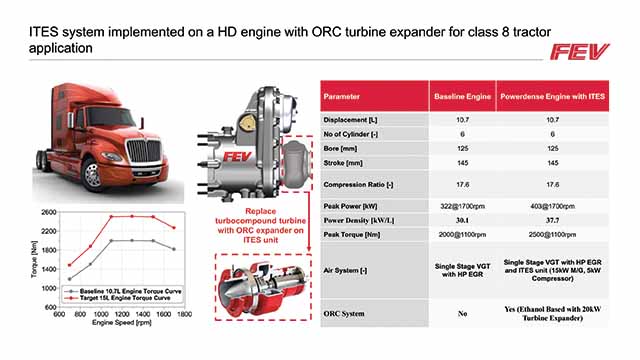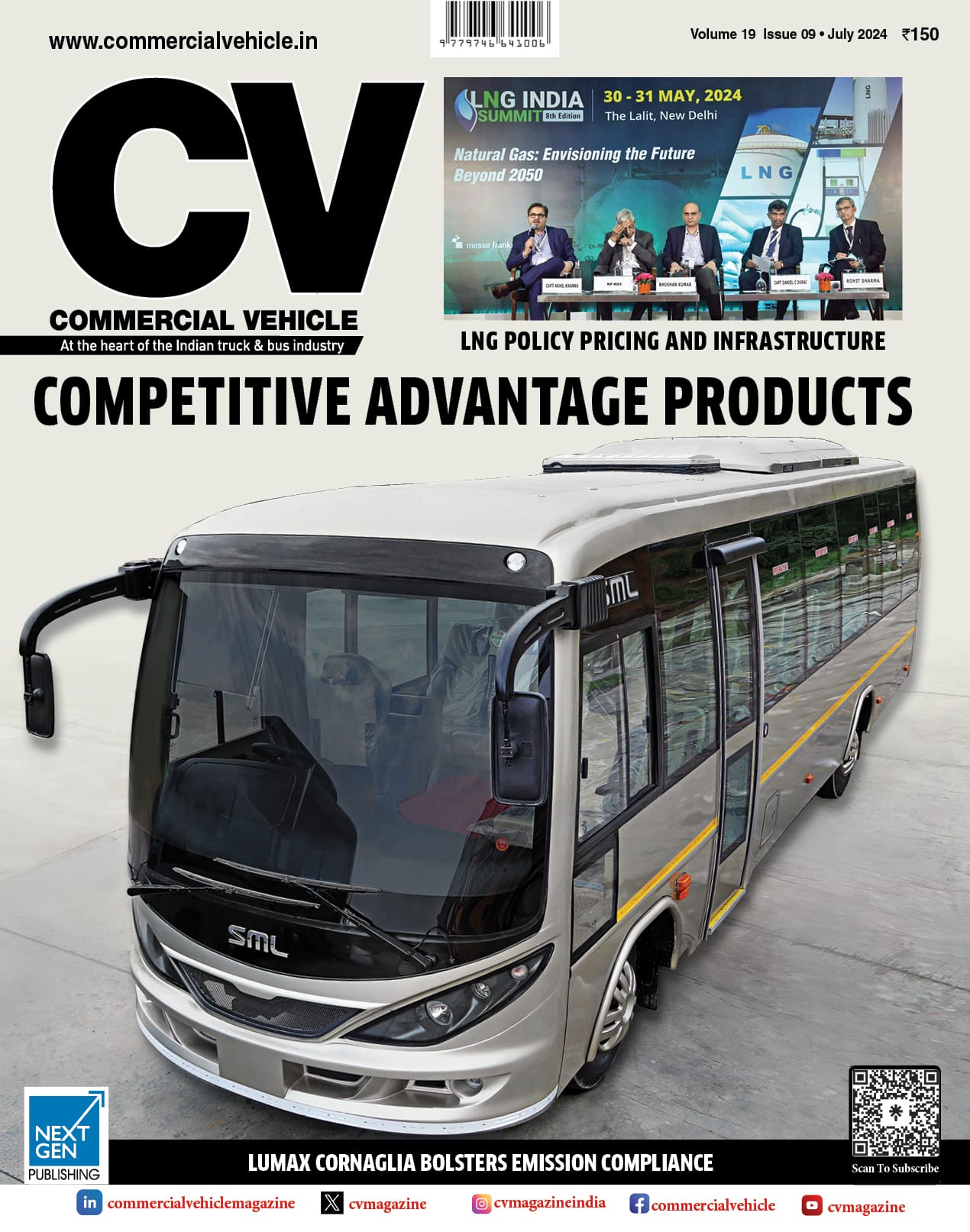
Story by:
Nikhil Raghavan
Forschungsgesellschaft für Energietechnik und Verbrennungsmotoren (FEV), an internationally-recognised leader in the design and development of internal combustion engines, conventional, electric, and alternative vehicle drive systems, energy technology, and a major supplier of advanced testing and instrumentation products and services to some of the world’s largest OEMs, has developed a new technology, Integrated Turbine, Electrification and Supercharging System (ITES). This system integrates turbo-compounding, electrification and supercharging into one auxiliary component of a medium- or heavy-duty engine.

The unit integrates a turbo-compound turbine, a centrifugal compressor and an electric motor-generator over a planetary gear set and is mechanically connected to the engine crankshaft via a clutch. This approach reduces cost and required space, and provides an increase in engine efficiency when compared to the independent integration of each of these technologies. FEV predicts up to 15 per cent fuel economy improvement for a medium-duty truck on an FTP certification cycle with a downsized engine and the ITES system. Satyum Joshi, Senior Engineer of Commercial Engines at FEV North America Inc., detailed the technical aspects of the ITES system and the importance of developing fuel-efficient components.
Engine efficiency and cost trade-off
Various factors impact increase in engine efficiency. The prime movers have always been regulations and customer requirements followed by market competition, rise of electrification, and oil prices. Engine efficiency can be increased by commonisation for cost reduction and future NOx regulations than by engine-specific regulations. As affordability is the key, how to increase engine efficiency, and at what cost are very important questions.
ITES System
Engine downsizing with e-booster can enable six-per cent increase in engine efficiency while maintaining transient performance of a Medium-Duty (MD) engine. A 200 rpm engine down-speeding with e-booster can increase engine efficiency by an average of four-per cent and reduce transient emissions on MD engine. Mechanical turbo-compounding can improve engine efficiency at higher engine speed and loads by two-per cent on a MD engine. Up to 16 per cent benefit in vehicle fuel economy can be realised with 48V P0 architecture mild hybridisation on LD application (8500 lb GVWR). FEV’s ITES integrates technologies while minimising and maximising efficiency.

The basic concept of ITES is to integrate a secondary compressor, turbo-compound or (Organic Rankine Cycle) ORC turbine, motor-generator unit over a planetary gear set. ITES is operated in four different modes in specific regions of the engine map to maximise engine efficiency gains with each technology. Applied on MD engine installed in a class 6-7 vocational application, ITES enabled an average of eight-per cent reduction in engine fuel consumption on the downsized engine in comparison to the baseline engine. Baseline six-cylinder engine was downsized to a four-cylinder engine and integrated independently with e-booster, mechanical turbo-compounding and Belt-driven Starter Generator (BSG) for comparison with ITES. In comparison to independent integration, ITES provides higher efficiency improvement along with the advantage of lower cost and package size.
ITES analysis on engine test cycles for on-highway and off-highway MD application noted up to 13 per cent reduction in fuel consumption. ITES can enable 11 per cent increase in vehicle fuel economy of class 6-7 vocational truck on ARB transient cycle. ITES was implemented on a HD engine with ORC turbine expander for class 8 tractor applications. It enabled power-dense engine with ORC system to achieve an average of five-per cent reduction in BSFC on the engine map in comparison to baseline engine. Up to one-per cent increase in engine efficiency was observed with the ITES in comparison to independent integration of ORC system, e-booster and mild hybridisation. In brief, ITES provides a lower cost, smaller package and higher efficiency approach to integration of waste heat recovery, low voltage electrification and supercharging.
————————————
In arrangement with Mobility Engineering. The views expressed by the author are his personal opinion and do not necessarily reflect the views of the CV magazine.

Satyum Joshi, Senior Engineer of Commercial Engines at FEV North America Inc.
Q: How will fleet operators in India benefit from ITES technology?
In India, we expect the technology to provide up to 10 per cent increase in vehicle fuel economy of medium and heavy-duty trucks. Furthermore, the ability of ITES system to provide torque assist will provide benefit during vehicle launch as well as hill climb. We expect that the ITES technology will be a boon to countries like India, Europe and China where stringent CO2 emission norms are in the process of being implemented in stages, whereas it is in an advanced stage in the US.
Q: With the incorporation of ITES in the engine composition and configuration, will there be a change in the architecture of the overall vehicle?
There will be a dimensional change in the engine which will eventually reflect in the design of the vehicle itself. While, in the cabin there will be more space for the driver, the overall length of the vehicle can be reduced to offer better drivability of longer trucks and buses. There will be better visibility too.
Q: For how long have you been working on the ITES technology?
The idea was developed by our team in 2017 and since then we have further developed the technology through extensive analysis for performance, durability, cost and complexity.
Q: Which are the countries (and manufacturers) of vehicles where trials are being conducted?
No trails are being conducted at the moment. We are close to development of prototype for testing. There is strong interest for the technology in China.
Q: You have mentioned that ITES will be a boon to India, Europe and China. These are vastly diverse topographies and nations. How do you evaluate the anticipated benefits in these three? Specific to India, what suggestions do you have?
Yes, however, three items are common: Upcoming stringent CO2 regulations, strong push for electrification (from government as well as customers) and lot of start (or stop) drive cycles for medium duty and heavy-duty applications.
Q: Once the ITES is finalised, do you suggest kits or transfer of technology or any other mode?
Yes, ITES will be provided as an add-on solution for MD and HD engines. Any manufacturer can partner with us and we can develop an ITES system specific to their application.



























